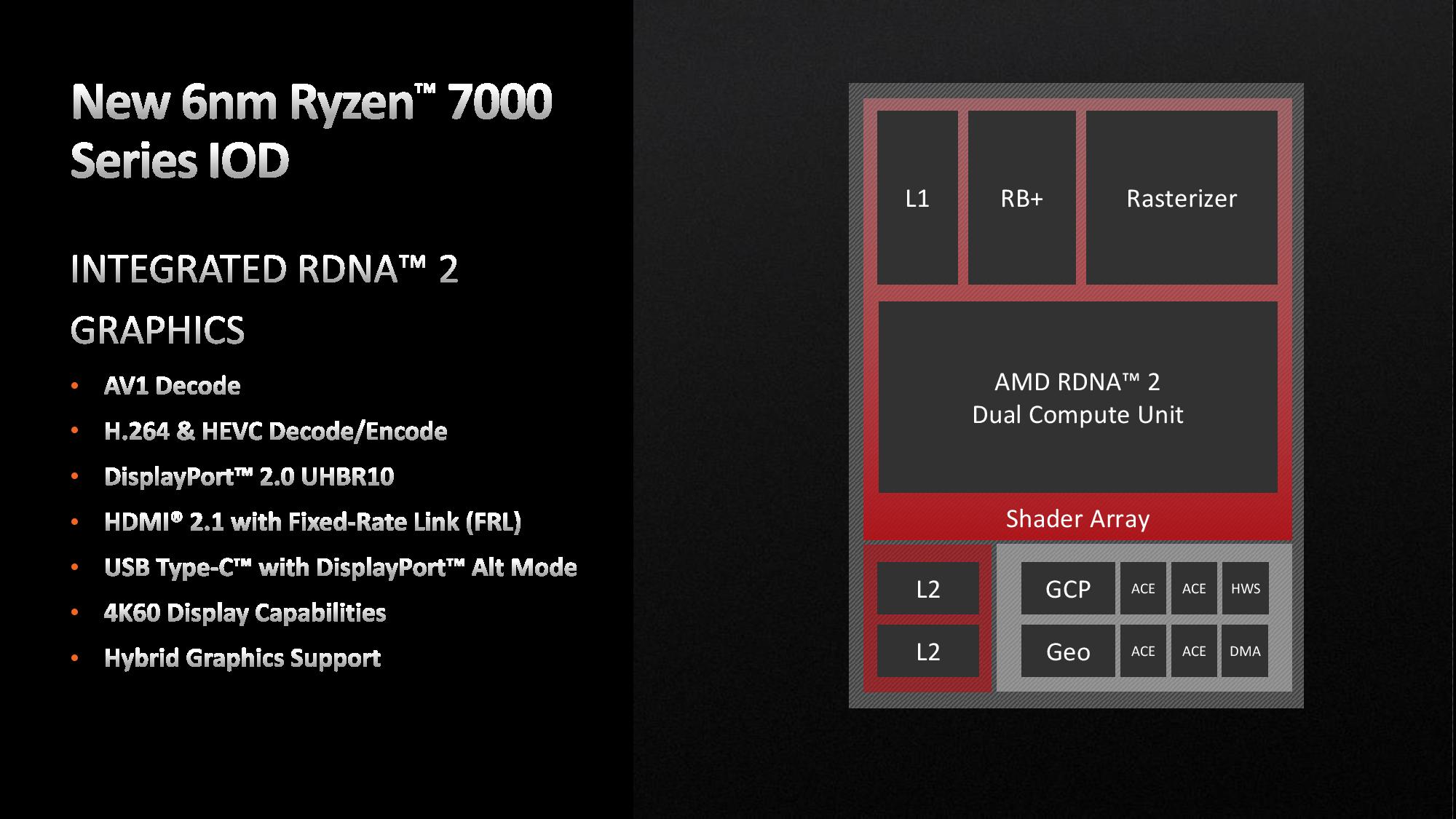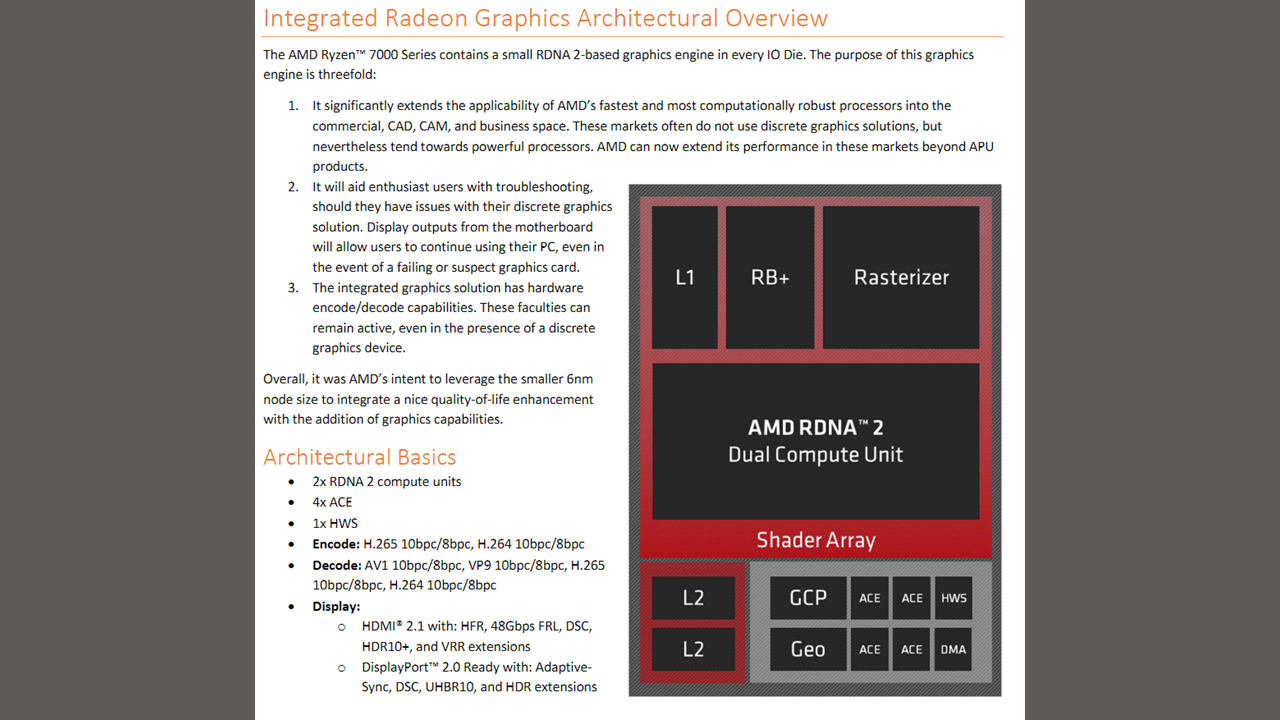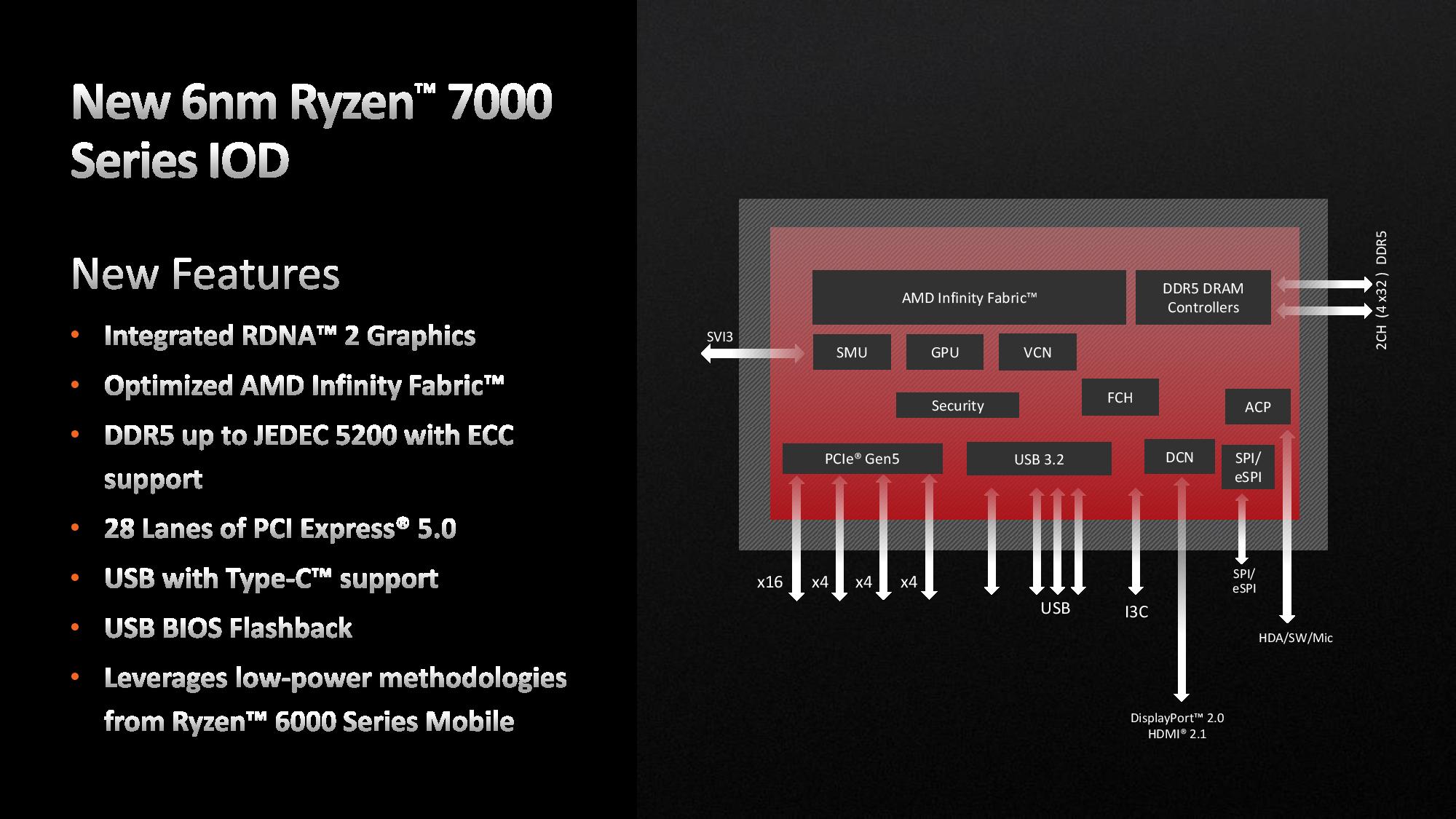Tested: No, Ryzen 7950X3D's iGPU Isn't 4X Faster
PC Mag article claims that new CPU's V-Cache helps with integrated graphics.

AMD's Ryzen 9 7950X3D debuted earlier this week to critical acclaim as it dethroned Intel's Core i9-13900K as the best CPU for gaming when paired with a discrete GPU. However, PC Mag reported in its 7950X3D review that AMD's 3D V-Cache tech, the chip-stacking technology behind the big gains in gaming performance, resulted in a 3x to 4x increase in the performance of the tiny integrated GPU onboard over the standard Ryzen 9 7950X. PC Mag's results were later picked up and cited by a number of other publications who clearly did not do their own testing.
While this wouldn't be very exciting with the basic RDNA 2 iGPU aboard the Ryzen 7000 series processors, that type of performance gain would theoretically be phenomenal if the tech were applied to an APU, setting enthusiasts' hopes alight with the news. However, we put the performance claims to the test through our own battery of iGPU tests and found that the cited test results appear to be in error.
When we first read PC Mag's report and the subsequent stories about it by other outlets, the results seemed questionable due to a few technical aspects. First, both CPUs have the same basic graphics engine, and the performance-boosting cache is located on just one of the 7950X3D's two compute chiplets.
However, the iGPU resides on the I/O die and is a self-contained unit with its own L2 cache. As such, it doesn't access the L3 cache on the compute die in any meaningful way (diagram further below in the article). Therefore, any performance gains couldn't come from additional cache bandwidth.
Rather, any increase would have to come from the 7950X3D's phenomenal gains in CPU compute performance. That would push the GPU even harder, but the CPU isn't the limiting factor. The Ryzen 9 7950X3D's iGPU only has two RDNA 2 compute units (CU) at its disposal, so it doesn't have the necessary horsepower to benefit from increased memory bandwidth or a faster CPU. This unit is entirely GPU compute-bound.
One more quick tidbit. AMD has been quite clear that the Ryzen 7000-series' new iGPU isn't meant for any type of meaningful gaming. Instead, it's meant to provide basic display-out capabilities for troubleshooting and the like as well as enough performance for watching videos and doing basic office tasks.
So even though these results are far from inspiring, the GPU is doing exactly what it's supposed to do. Besides, no one in their right mind would buy the $699 Ryzen 9 7950X3D to game on its integrated graphics, so bear in mind that we're doing this for science.
| Tom's Hardware | 7950X3D vs 7950X | 7950X3D (fps) | 7950X (fps) |
|---|---|---|---|
| Dota 2 - 1280 | +1.60% | 233.2 | 229.5 |
| Dota 2 -1920 | +1.8% | 228.7 | 224.5 |
| F1 2021 - 1280 | 0.42% | 71.3 | 71 |
| F1 2021 - 1920 | +0.80% | 37.9 | 37.6 |
| Shadow Tomb Raider - 1280 | +0.60% | 32.4 | 32.2 |
| Shadow Tomb Raider - 1920 | +1.00% | 19.6 | 19.4 |
| Strange Brigade - 1280 | Same | 49.7 | 49.7 |
| Strange Brigade - 1920 | -0.80% | 24.1 | 24.3 |
| Grand Theft Auto V - 1280 | +0.67% | 105.1 | 104.4 |
| Grand Theft Auto V - 1920 | +0.89% | 56.4 | 55.9 |
We ran a series of benchmarks with five titles: Dota 2, F1 2021, Shadow of the Tomb Raider, Strange Brigade, and Grand Theft Auto V, at 1920x1080 and 1280x720 resolutions to test the performance of the Ryzen 9 7950X3D's integrated GPU versus the Ryzen 9 7950X's iGPU. We used either low or medium settings for these titles. For our testing, we used the same ASRock X670E Taichi motherboard and config we used for our Ryzen 9 7950X review.
The first column sums it up well: The results are mostly within one percentage point of each other. And with performance this low, that mostly amounts to less than one fps of difference between the two configs. That small delta falls within the expected run-to-run variation of these benchmarks, so you can safely view these as a tie. There is no difference in performance between these two iGPUs.
Testing integrated graphics is a fruitless and irritating chore. This is often an exercise in patience as you're treated to games that look like slideshows because they run so slowly. However, being gluttons for punishment, we ran one more series of tests to squash the debate.
| Tom's Hardware | X3D Chiplet vs Bare | X3D Chiplet (CCD 0, fps) | Non-X3D Chiplet (CCD 1, fps) |
|---|---|---|---|
| Dota 2 - 1280 | +1.20% | 234.2 | 231.4 |
| Dota 2 -1920 | +0.80% | 229 | 227.1 |
| F1 2021 - 1280 | +1.57% | 71 | 69.9 |
| F1 2021 - 1920 | +0.50% | 37.3 | 37.1 |
| Shadow Tomb Raider - 1280 | +0.94% | 32.3 | 32 |
| Shadow Tomb Raider - 1920 | +0.50% | 19.6 | 19.5 |
| Strange Brigade - 1280 | -1.00% | 49.1 | 49.6 |
| Strange Brigade - 1920 | Same | 24.2 | 24.2 |
| Grand Theft Auto V - 1280 | Same | 106 | 106 |
| Grand Theft Auto V - 1920 | +0.90% | 56 | 55.5 |
The Ryzen 9 7950X3D and the Ryzen 9 7950X have some minor differences, but there is a way to further narrow down any potential gains from the 3D V-Cache tech: The 7950X3D has two chiplets, one with 3D V-Cache and a 'bare' chiplet without the 3D-stacked cache. We disabled one chiplet for each of these series of tests, therefore either running the games on only the 3D V-Cache chiplet or on the bare chiplet.
As we've shown extensively in our other testing of these two types of chiplets, there is a clock frequency difference between these two chips. The bare chiplet is around 500 MHz faster, but this is about as apples-to-apples for this testing as we can get.
Again, there is no meaningful difference between the chiplets. Even if the X3D stacking tech could help, the Ryzen 9 7950X3D's integrated RDNA 2 iGPU isn't strong enough to utilize the additional resources. The RDNA 2 iGPU comes with two compute units, 4 ACE, and 1 HWS, so that should be pretty apparent.




Our testing shows that the 7950X3D's iGPU remains just as compute-starved as the identical unit on the Ryzen 9 7950X, so there are no gains to be had. Not that it's much of a competition — Intel's iGPU is also basically worthless for gaming. Given our results today, it's safe to say that nothing has changed with the Ryzen 7000-series RDNA 2 iGPU's relative performance positioning against Intel, which you can see here.
Does this mean that AMD's 3D V-Cache tech wouldn't prove to be revolutionary on an APU? Not by any means, as AMD could theoretically forge a design that could leverage the increased throughput of a 3D-stacked cache.
In fact, the Infinity Cache on the RDNA 2 and RDNA 3 dedicated GPUs is basically exactly that idea, and yet AMD chose to omit any Infinity Cache on the integrated RDNA 2 solutions we've seen. In short, putting lots of cache on an integrated GPU doesn't seem likely given that AMD has used its monolithic APU chips to target the low end of the market where the premium pricing of 3D V-Cache simply wouldn't make any sense — unless you count the Xbox Series X and PlayStation 5. It might sound nice, but in practice AMD has other goals in mind for the PC market.
Get Tom's Hardware's best news and in-depth reviews, straight to your inbox.

Paul Alcorn is the Editor-in-Chief for Tom's Hardware US. He also writes news and reviews on CPUs, storage, and enterprise hardware.
-
usertests The problem I had with the story is that it portrayed the 2 CU Ryzen 7000 iGPU as much weaker than the 32 EU UHD 770 used in Alder Lake and Raptor Lake, when other tests I've seen show them as about equal.Reply
Source:
https://www.techpowerup.com/review/amd-ryzen-7-7700x/22.htmlhttps://arstechnica.com/gadgets/2022/09/ryzen-7600x-and-7950x-review-zen-4-starts-off-expensive-but-impressive/5/#h2
Michael Justin Allen Sexton said:Simply put, Intel's IGPs are far more powerful. The irony of this situation is almost painful: AMD not only has far more experience making GPUs but it also makes far more powerful IGPs in other products.
Simply untrue, guy with 4 names. -
deesider ReplySimply put, Intel's IGPs are far more powerful...
I'm not sure critical thinking is his forte.
AMD ... also makes far more powerful IGPs in other products. -
JamesJones44 Honest question because I haven't had time to review the architecture. Does the 7xxxX3D iGPU even have an interconnect to the V-Cache? I didn't think AMD was structuring the V-Cache to act like a UMA layer for both the CPU and GPU.Reply -
InvalidError Reply
The CPU has to be cache-coherent, so it would make sense for the IGP to access stuff in-cache if it happens to be there (ex.: draw command queue) so it doesn't waste time fetching a stale copy from system memory. Doubt it has any mean of using the CPU cache as its own in any other way.JamesJones44 said:I didn't think AMD was structuring the V-Cache to act like a UMA layer for both the CPU and GPU. -
AgentBirdnest Props to Paul for investigating and testing this. : ) You do good work.Reply
PC Mag updated their article:
PC Mag said:Editors' Note, March 2, 2023: Some scrutiny by Tom's Hardware(Opens in a new window) and online commenters pointed out that our integrated graphics (IGP) testing numbers for the earlier Ryzen 9 7950X chip were unnaturally low; this was likely due to early-driver issues that only became evident with this review of the 7950X3D, and made the 7950X3D's IGP look like a leap forward by comparison. We have retested the Ryzen 9 7950X and updated the numbers in the IGP testing table here and in that original review, and made minor tweaks to this article's intro and IGP Testing section to reflect the new numbers. We'll also be retesting the IGPs on the Ryzen 7 7700 and 7700X in the coming days. The original, fundamental conclusions we made about this chip, though, have not changed. -
Amdlova Long time ago, before the hummus sapiens... intel make a cpu with edram crystal well with true 128mb l4 cache. Maybe has helped with graphics... but that glue amd shinigamis have can't be too good :)Reply -
rluker5 It is good this came out. Generally speaking, desktop igpus are terrible at gaming. Pretending they are good is just setting people up for disappointment.Reply
One can be better than the other, but if they are still worse than a 10 year old dgpu, sorry they are terrible.
But they are good for non gaming display tasks, have been for a long time and having one is a big usability improvement for Ryzen for those who don't game. -
InvalidError Reply
Depends on the IGP: while the basic IGP in Intel and AMD's normal desktop lineups may be only adequate for basic desktop use and simple games. Intel's mobile IGPs with ~3X the performance is getting into usable territory and AMD's latest 780M does make most current sub-$200 GPUs irrelevant performance-wise.rluker5 said:It is good this came out. Generally speaking, desktop igpus are terrible at gaming. Pretending they are good is just setting people up for disappointment.
One can be better than the other, but if they are still worse than a 10 year old dgpu, sorry they are terrible.
Once AMD or Intel decides to bring some DRAM on-package, we'll probably see "big IGPs" aiming somewhere in the neighborhood of RTX4060-4070 performance with a tile/chiplet whatever the size the DRAM chips stacked on top of it are. -
JamesJones44 ReplyInvalidError said:Depends on the IGP: while the basic IGP in Intel and AMD's normal desktop lineups may be only adequate for basic desktop use and simple games. Intel's mobile IGPs with ~3X the performance is getting into usable territory and AMD's latest 780M does make most current sub-$200 GPUs irrelevant performance-wise.
Once AMD or Intel decides to bring some DRAM on-package, we'll probably see "big IGPs" aiming somewhere in the neighborhood of RTX4060-4070 performance with a tile/chiplet whatever the size the DRAM chips stacked on top of it are.
Totally agree here. DRAM on package will likely allow iGPUs to compete for lower end dGPU share. -
rluker5 Reply
That is a relative measure. You can call phone graphics fast by a relative measure, but compared to the standard of desktop graphics they are not.InvalidError said:Depends on the IGP: while the basic IGP in Intel and AMD's normal desktop lineups may be only adequate for basic desktop use and simple games. Intel's mobile IGPs with ~3X the performance is getting into usable territory and AMD's latest 780M does make most current sub-$200 GPUs irrelevant performance-wise.
Once AMD or Intel decides to bring some DRAM on-package, we'll probably see "big IGPs" aiming somewhere in the neighborhood of RTX4060-4070 performance with a tile/chiplet whatever the size the DRAM chips stacked on top of it are.
The 680m is slower than a 2013 290x. And an A380. At least according to Techpowerup.
The 680m, while excellent as a low power/low performance mobile solution, can't be called good in terms of the normal accepted reference of desktop gaming.
The igpu in a 7700x or 12700k is hardly a 680m when it comes to gaming.
People hoping otherwise will be let down.
But they do display the desktop and play video quite well. At least the Intel ones. I'm just assuming the AMD ones do as well since their dgpus are up to normal standards.